Becca C. Smith's Blog, page 7
December 31, 2014
The aftermath of Nanowrimo
 It's December 31st. The last day of 2014. I figured it was time to write about my experience with NaNoWrimo before the year was up.
It's December 31st. The last day of 2014. I figured it was time to write about my experience with NaNoWrimo before the year was up.It was really an eye-opening experience for me. It solidified for me that my writing process works just fine without having to write thousands of words a day. Don't get me wrong: I LOVED NaNoWrimo and plan to do it every year from now on. But I now know HOW I want to use it.
This was my first year so I figured I'd come up with an idea a week before it started, outline it and write the whole book in November.
I did this.
And it fried my brain, lol!
I'm a fast writer, but dang! I had to write 3,000 words a day to finish my book. And what did I end up with?
A total mess.
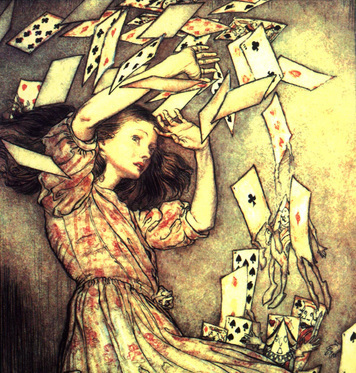 But I took the advice of the many who had completed NaNo before me and left the manuscript alone until mid-December. After reading the first chapter, I knew it was too soon. Something was missing. Something important, vital to salvaging anything that I wrote the entire month of November.
But I took the advice of the many who had completed NaNo before me and left the manuscript alone until mid-December. After reading the first chapter, I knew it was too soon. Something was missing. Something important, vital to salvaging anything that I wrote the entire month of November.But yesterday everything fell into place in my brain. All the missing pieces came together and I know now what I have to do to fix it. But it's going to be a huge re-write! I have to thread through an entire sub-plot and change my character's history to make it work, but I have faith now that it could end up being a novel I could be proud of.
What I learned from this?
My brain takes time percolate. I'm an outliner by nature, but I still deviate from the outline as ideas come to me. NaNoWrimo doesn't allow for percolating. It's a sports car driving down the freeway at a 100 miles an hour.
Next year I'm going to use NaNo differently. I'm not going to write a novel from scratch. I'll use it as a motivator to write 50K of whatever I happen to be working on. I admit, I was a little overzealous writing a 70K novel. Next time, I'll stick to the 50K, not try and finish early and just enjoy the ride!
Here's to next year :-)

Published on December 31, 2014 12:53
October 29, 2014
5 Easy ways to outline your novel
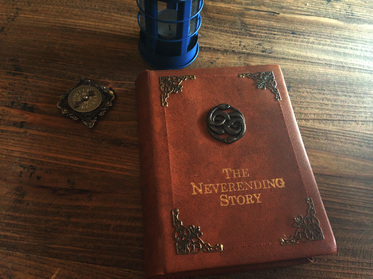 Outlining is one of those tools that authors either use religiously or are adamantly against. I am in the outlining club, simply because my brain is way too scattered to write without one. If I didn’t use an outline I guarantee nothing I wrote would make any sense and I might as well title all my books “Tangent Central.”
Outlining is one of those tools that authors either use religiously or are adamantly against. I am in the outlining club, simply because my brain is way too scattered to write without one. If I didn’t use an outline I guarantee nothing I wrote would make any sense and I might as well title all my books “Tangent Central.”For those of you who want to take a stab at outlining, this is how I do it in 5 easy steps.
1. Decide how long your book is going to be.
Word count. For me, it’s usually between 60k-100k.
2. Decide how many chapters your book will have and divide that number by your word count.
This will give you an estimate as to how long each chapter will be. For example, if my word count estimate is 60k and I want the book to have 20 chapters, then each chapter will be approximately 3,000 words.
3. Type out each chapter title in a document with no descriptions yet.
This will be the base of your outline.
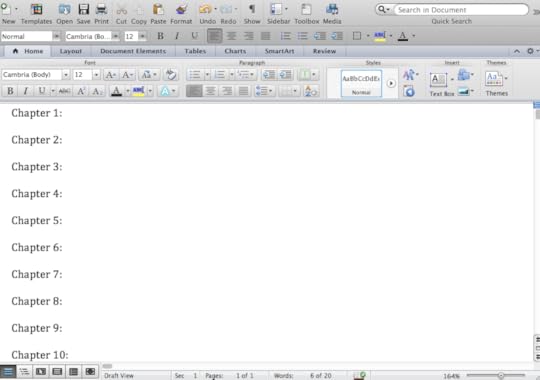 4. Write short sentence descriptions of approximately where you want your major events to take place.
4. Write short sentence descriptions of approximately where you want your major events to take place.
This is where you’ll type in all the major scenes you’ve been kicking around your head since you thought of your story idea. Such as where you want a character to die, or where you want them to commit to the journey, or where you want the resolution to start.
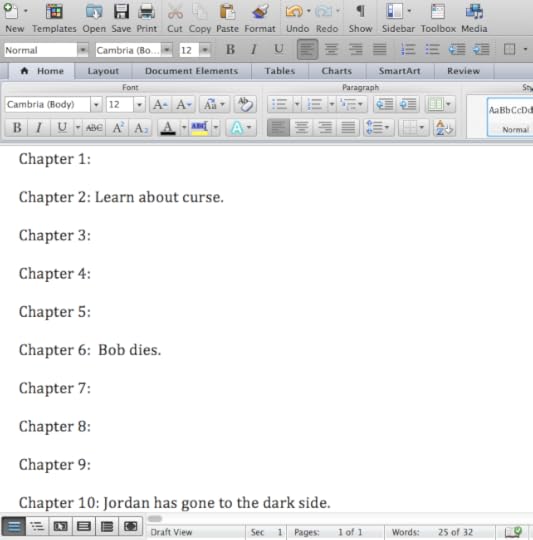 5. Once you have the key events in place, fill in the other chapters with short sentences that lead up to that event.
5. Once you have the key events in place, fill in the other chapters with short sentences that lead up to that event.
Doing it this way helps the brain work out how you want to get your characters to certain places in your story. Sometimes we get bogged down in key scenes and have no idea what the glue is that will bind it all together. For me, laying out the basics in the position I want them visually, helps me figure out how my characters will get there.
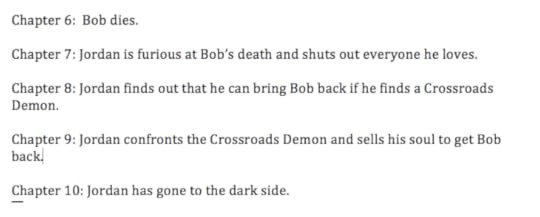 Everyones' process is different and there is no right or wrong way to write a book. This is just how I do it :-)
Everyones' process is different and there is no right or wrong way to write a book. This is just how I do it :-)Hope it helps!
Published on October 29, 2014 10:34
October 27, 2014
Keep Calm and write On
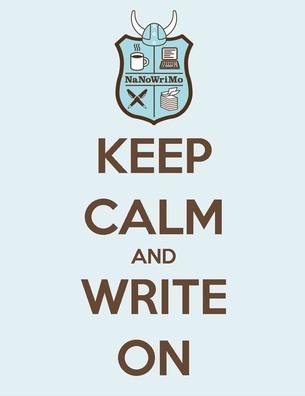 This will be my mantra for the month of November! I’ve decided to do NaNo this year. For those of you who don’t know what NaNo is, it’s a group of writers who write a novel in a month. There is a website that organizes it all, from Forums to connect with other authors, to earning badges for your word count. (The ocd part of me loves the concept of earning badges the most!)
This will be my mantra for the month of November! I’ve decided to do NaNo this year. For those of you who don’t know what NaNo is, it’s a group of writers who write a novel in a month. There is a website that organizes it all, from Forums to connect with other authors, to earning badges for your word count. (The ocd part of me loves the concept of earning badges the most!) Here’s the site: www.nanowrimo.org
I’ve decided to work on a new project. I came up with the idea this week and am outlining like crazy so I’ll be ready to begin writing on November 1st.
It’ll be a YA/Mystery/Thriller with a hint of the supernatural. (The main character dreams of murders that really happen.) Usually, my books are completely supernatural with badass superpowers mixed with science and mythology. But this will all be set in reality. It’ll be a lot darker than my usual work, but since the main character is sixteen, it will still have a similar vibe in terms of voice. I don’t have a title yet, but hopefully that will come as I delve deeper into the story.
I know so many people who have used NaNo to help them finish their novels. It usually takes me about three to four months to finish one of my books so doing it in a month seems a little insane. But I’m up for the challenge. Some of my best work has been writing mass amounts of words in the wee hours of the night.
My goal is to have a finished rough draft of approximately 60-80 thousand words by the end of November. Then I want to edit the heck out of it in December!
I’m super excited to start! If anyone wants to buddy up with me on the Nano site my handle is: beccacsmith.
Hope to see you there!
Published on October 27, 2014 15:27
October 17, 2014
6 steps for managing Anxiety!
Anxiety. Everyone has it to a certain degree, some more than others. I’ve struggled with it my entire life. From panic attacks to digestive issues, anxiety is something I deal with on a daily basis.
Over the years I’ve discovered some tricks that help me manage my stress. It took a long time to figure out and I still have what I call “surges” everyday (fight or flight: that feeling that you can’t breathe), but I now know how to stop them in their tracks. Or at least slow them down long enough for me to calm myself.
The first three steps are for stopping a panic attack.
1. Five count breathing.
This is an easy way to break out of the terror of feeling like you can’t breathe. When I’m having an attack, I literally feel like I’m dying. It’s as if I’m not getting enough oxygen and I’m going to pass out and die right there. Logically, I know this isn’t true, but in the moment, my brain doesn’t listen to my head :-)
Five count breathing is when you breathe in for five seconds, hold it for five, release the breath for five, then hold it for another five. Repeat this as long as it takes until you can breathe normally again. Trust me, I’ve had to do the five count technique for a full half hour sometimes. So, don’t stress if it doesn’t work right away.
2. Heating pad.
This technique is my best friend. I try to stay away from electric heating pads, only because I don’t want to leave the heat on for more than a half hour. Whenever I feel even the slightest feeling that I’m about to have a panic attack, I heat up my neck warmer and place it on my chest. I use the neck warmer because it slowly loses its heat in about a half hour, which is the perfect length of time for me.
3. Walk/pace.
This feeds into the fight or flight. You’re essentially using the “flight” part of the equation. I usually use both the five count breathing and walking techniques together. You don’t have to go outside for a walk, pacing around your house works just fine as well. It helps jolt you out of your head. You can even try another breathing technique where you say a word in your head every time you breathe in and out, such as, when you breathe in you say the word, “heal” and when you breathe out you say the word, “calm.” This helps me quiet down the rowdy party going on in my brain and/or the thoughts of utter doom :-)
For long term stress and anxiety relief, I do the following:
4. Drink lots of tea.
This has become a must for me. It has not only helped my anxiety, but my digestion as well. You’ll find that most teas used for digestion issues are also used to calm your body as well.
I use Fennel seed tea, chamomile and Yogi’s Stomach Ease. Rotating between these teas every day has changed my life!

 5. Magnesium.
5. Magnesium.
I started taking Magnesium because I have mitral valve prolapse and the metals help keep my heart beating properly. But, Magnesium has also been proven to help anxiety as well. I take a slow-release supplement to protect my stomach, but I also eat a diet high in Magnesium as well. Having a smoothie with bananas, spinach, yogurt and blueberries is not only tasty, but will help your stress levels.
Here’s some information on the benefits of Magnesium:
http://www.nlm.nih.gov/medlineplus/druginfo/natural/998.html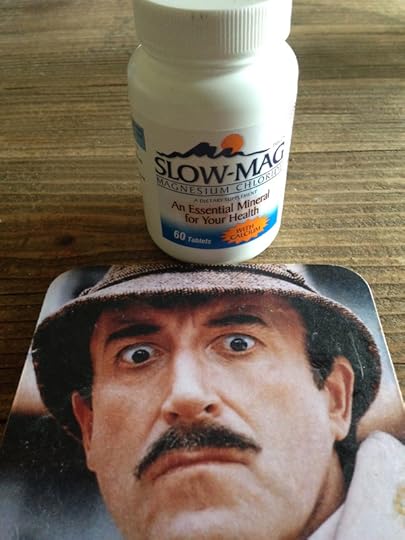 6. Exercise.
6. Exercise.
I know a lot of people don’t like this option, but it really does work. You don’t have to go to a gym or do anything strenuous. You simply have to walk. Walk for a half hour, or an hour, or more if you like. I use the elliptical every day for 45 minutes, basically, the time it takes to watch one of my favorite television shows. Cardio is the best for anxiety and walking or running can really help.
These are just some tips that I use to manage my anxiety. Everyone is different of course, but I hope it helps!
Over the years I’ve discovered some tricks that help me manage my stress. It took a long time to figure out and I still have what I call “surges” everyday (fight or flight: that feeling that you can’t breathe), but I now know how to stop them in their tracks. Or at least slow them down long enough for me to calm myself.
The first three steps are for stopping a panic attack.
1. Five count breathing.
This is an easy way to break out of the terror of feeling like you can’t breathe. When I’m having an attack, I literally feel like I’m dying. It’s as if I’m not getting enough oxygen and I’m going to pass out and die right there. Logically, I know this isn’t true, but in the moment, my brain doesn’t listen to my head :-)
Five count breathing is when you breathe in for five seconds, hold it for five, release the breath for five, then hold it for another five. Repeat this as long as it takes until you can breathe normally again. Trust me, I’ve had to do the five count technique for a full half hour sometimes. So, don’t stress if it doesn’t work right away.
2. Heating pad.
This technique is my best friend. I try to stay away from electric heating pads, only because I don’t want to leave the heat on for more than a half hour. Whenever I feel even the slightest feeling that I’m about to have a panic attack, I heat up my neck warmer and place it on my chest. I use the neck warmer because it slowly loses its heat in about a half hour, which is the perfect length of time for me.
3. Walk/pace.
This feeds into the fight or flight. You’re essentially using the “flight” part of the equation. I usually use both the five count breathing and walking techniques together. You don’t have to go outside for a walk, pacing around your house works just fine as well. It helps jolt you out of your head. You can even try another breathing technique where you say a word in your head every time you breathe in and out, such as, when you breathe in you say the word, “heal” and when you breathe out you say the word, “calm.” This helps me quiet down the rowdy party going on in my brain and/or the thoughts of utter doom :-)
For long term stress and anxiety relief, I do the following:
4. Drink lots of tea.
This has become a must for me. It has not only helped my anxiety, but my digestion as well. You’ll find that most teas used for digestion issues are also used to calm your body as well.
I use Fennel seed tea, chamomile and Yogi’s Stomach Ease. Rotating between these teas every day has changed my life!

 5. Magnesium.
5. Magnesium.
I started taking Magnesium because I have mitral valve prolapse and the metals help keep my heart beating properly. But, Magnesium has also been proven to help anxiety as well. I take a slow-release supplement to protect my stomach, but I also eat a diet high in Magnesium as well. Having a smoothie with bananas, spinach, yogurt and blueberries is not only tasty, but will help your stress levels.
Here’s some information on the benefits of Magnesium:
http://www.nlm.nih.gov/medlineplus/druginfo/natural/998.html
 6. Exercise.
6. Exercise.I know a lot of people don’t like this option, but it really does work. You don’t have to go to a gym or do anything strenuous. You simply have to walk. Walk for a half hour, or an hour, or more if you like. I use the elliptical every day for 45 minutes, basically, the time it takes to watch one of my favorite television shows. Cardio is the best for anxiety and walking or running can really help.
These are just some tips that I use to manage my anxiety. Everyone is different of course, but I hope it helps!
Published on October 17, 2014 14:23
October 6, 2014
The pain of Grief
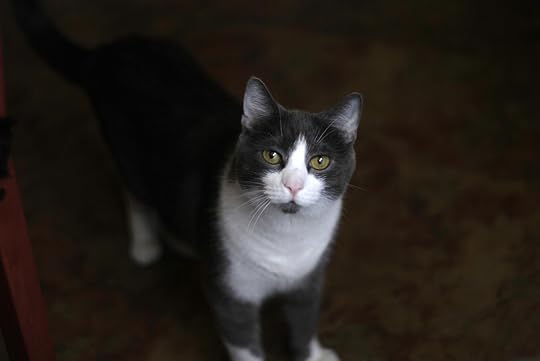 It hurts so much you can’t even imagine feeling normal again. One minute you think you have it together, the next your bawling your eyes out.
It hurts so much you can’t even imagine feeling normal again. One minute you think you have it together, the next your bawling your eyes out. Loss is loss, whether it’s a human loss or a beloved pet, the feeling of emptiness they leave behind never goes away completely. It’s like a piece of your soul is forever damaged because you’ll never see them again in this life.
I just lost my cat, Jack. He was fifteen and lived a full and quirky life. He made me laugh with his odd personality traits and his adorable meow. I miss him so much, I still can’t believe that he’s gone. I keep waiting for him to come up and get his daily scratchies while I watch television. It’s been a few days, so the pain comes in waves. It’ll get better over time. It always does with death.
But I hate it.
I hate that death has to exist in life.
It’s probably why most of the fiction I write involves immortal characters. In my first book series, I created a world where scientists invent a little pill called Age-pro, which makes you live forever. As farfetched as it sounds, it’s actually not that far off. More money is spent on anti-aging research than most research for diseases! It’s an 80 billion dollar industry. People’s obsession with being young forever could ultimately lead to living forever.
I, selfishly, want this to happen. Not because I want to look young, but because I don’t want to lose anyone ever again. Death shouldn’t exist. We should never have to lose anyone we love. Because when we do lose our loved ones, we’re left with giant-sized holes in our chest that will never quite heal.
If there is an afterlife, I want it to be pulled back down to earth so we can all be together again, in this lifetime.
It just hurts.
Published on October 06, 2014 16:21
September 29, 2014
Intentions...
We all have wonderful intentions. In my brain, I have way too many of them. Intentions to write, intentions to market, intentions to sew, intentions to read… The list goes on and on until I finally realize that accomplishing all these things isn’t actually feasible to do in a short amount of time. So what do I do about it? I usually become so overwhelmed I do nothing or worse: procrastinate.
And that, in turn, leads to self-punishment and a whole lot of guilt trips.
The problem is: my mind seems to think that everything is on some kind of time clock that only I’m aware of. As if other people are waiting for me to finish my giant to-do list, when in reality, they could care less.
The only solution I’ve ever found that works for me is to create small, feasible goals. Something I can actually finish in a day. It also helps for me to divide my projects, such as designating certain days for certain tasks. So if my writing days are Monday, Wednesday and Friday, then I am only obligated to write on those days, anything else is gravy. That way I don’t get bogged down in the guilt of not finishing my endless list of things to do.
One step at a time, baby steps, whatever you want to call it. It works.
And that, in turn, leads to self-punishment and a whole lot of guilt trips.
The problem is: my mind seems to think that everything is on some kind of time clock that only I’m aware of. As if other people are waiting for me to finish my giant to-do list, when in reality, they could care less.
The only solution I’ve ever found that works for me is to create small, feasible goals. Something I can actually finish in a day. It also helps for me to divide my projects, such as designating certain days for certain tasks. So if my writing days are Monday, Wednesday and Friday, then I am only obligated to write on those days, anything else is gravy. That way I don’t get bogged down in the guilt of not finishing my endless list of things to do.
One step at a time, baby steps, whatever you want to call it. It works.
Published on September 29, 2014 11:32
October 30, 2013
A Day of Steampunk Sewing!
One time-lapsed day of a three day sewing spree with my friend Faith for making steampunk costumes for Halloween. I ended up making 2 corsets, 2 shirts, 2 pairs of bloomers and a skirt! Phew!
Published on October 30, 2013 17:56



